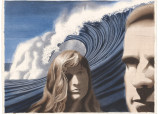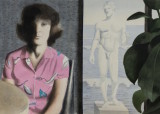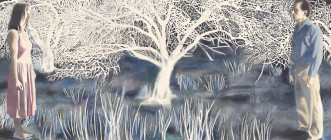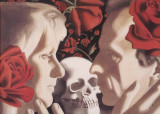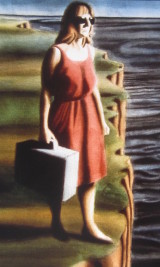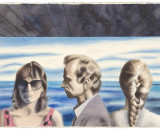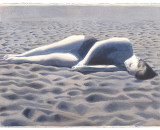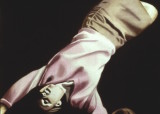A Seal Upon Thine Heart
This series of large watercolour paintings was inspired by the Canadian novel By Grand Central Station I Sat Down and Wept (1945). Elizabeth Smart’s autobiographical and scandalous story is written in a confessional prose poetry reminiscent of Rimbaud’s Illuminations or Baudelaire’s Les Fleurs du mal, but from a woman’s point of view. The rich language, combined with its subject matter, a woman detailing the highs and lows of a self-destructive love affair with a married man, created a hypnotic emotional effect. Robert tried to match this effect in a visual manner.
Robert was soaked in a Christian upbringing, which he had largely ignored until now. Smart’s novel offered a chance to explore Christian symbols and imagery under the guise of a bold bohemian attitude that is by turns self-mocking and ironical, at the same time searching for heightened experience and cosmic connections.
Robert did not engage with Elizabeth Smart’s novel because he was interested in realism. As a novel, By Grand Central Station moves far away from a linear narrative. If you asked ten different viewers to arrange Robert’s images in an order that tells a story, you would almost certainly get ten different answers. Each image in the series tackles a different aspect of love: the dangerous nature of love, the fragile nature of love, the addictive nature of love, elation, sadness, jealousy, feelings of total abandon, entrapment, longing.
Like a composer creating variations on a melody, Robert used the same two models, Heather Pitt and Dale Gorveat, in scene after scene, varying the composition, lighting and choreography to match mood and meaning. Robert adds many elements not present in the novel: the figures dancing on the cliff in High, and the skull and roses in A Seal Upon Thine Heart. Robert also invents his own metaphors in Butterfly, Plunge and Falling in Love. References to art history in Interior, Surf and The Lavishness of My Feelings add an additional layer.
Robert brought a film noir sensibility to the genre of pastoral romance: love is portrayed not as idyllic and peaceful, but rather as shadowy, confusing, full of disguises and misleading paths. In the plots of film noir, the hero or heroine is plunged into a murky underworld, where the values of right and wrong are hopelessly blurred. Robert’s lovers encounter a similar disorientation. Later, Robert used film noir motifs in his cancer series to provoke an analogous sense of shock and bewilderment.
